Dopaminergic modulation of GABAergic transmission in the entorhinal cortex: concerted roles of α1 adrenoreceptors, inward rectifier K⁺, and T-type Ca²⁺ channels
- PMID: 23843440
- PMCID: PMC4296123
- DOI: 10.1093/cercor/bht177
Dopaminergic modulation of GABAergic transmission in the entorhinal cortex: concerted roles of α1 adrenoreceptors, inward rectifier K⁺, and T-type Ca²⁺ channels
Abstract
Whereas the entorhinal cortex (EC) receives profuse dopaminergic innervations from the midbrain, the effects of dopamine (DA) on γ-Aminobutyric acid (GABA)ergic interneurons in this brain region have not been determined. We probed the actions of DA on GABAA receptor-mediated synaptic transmission in the EC. Application of DA increased the frequency, not the amplitude, of spontaneous IPSCs (sIPSCs) and miniature IPSCs (mIPSCs) recorded from entorhinal principal neurons, but slightly reduced the amplitude of the evoked IPSCs. The effects of DA were unexpectedly found to be mediated by α1 adrenoreceptors, but not by DA receptors. DA endogenously released by the application of amphetamine also increased the frequency of sIPSCs. Ca(2+) influx via T-type Ca(2+) channels was required for DA-induced facilitation of sIPSCs and mIPSCs. DA depolarized and enhanced the firing frequency of action potentials of interneurons. DA-induced depolarization was independent of extracellular Na(+) and Ca(2+) and did not require the functions of hyperpolarization-activated (Ih) channels and T-type Ca(2+) channels. DA-generated currents showed a reversal potential close to the K(+) reversal potential and inward rectification, suggesting that DA inhibits the inward rectifier K(+) channels (Kirs). Our results demonstrate that DA facilitates GABA release by activating α1 adrenoreceptors to inhibit Kirs, which further depolarize interneurons resulting in secondary Ca(2+) influx via T-type Ca(+) channels.
Keywords: GABAA receptor; depolarization; entorhinal; interneuron; synapse; synaptic transmission.
© The Author 2013. Published by Oxford University Press. All rights reserved. For Permissions, please e-mail: journals.permissions@oup.com.
Figures
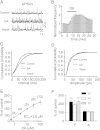
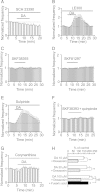
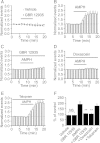
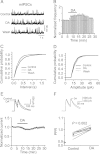
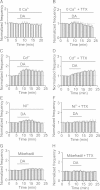
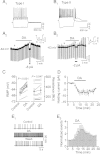

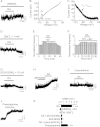
Similar articles
-
Adrenergic facilitation of GABAergic transmission in rat entorhinal cortex.J Neurophysiol. 2007 Nov;98(5):2868-77. doi: 10.1152/jn.00679.2007. Epub 2007 Sep 5. J Neurophysiol. 2007. PMID: 17804573
-
Inward rectifier K+ channel and T-type Ca2+ channel contribute to enhancement of GABAergic transmission induced by β1-adrenoceptor in the prefrontal cortex.Exp Neurol. 2017 Feb;288:51-61. doi: 10.1016/j.expneurol.2016.11.007. Epub 2016 Nov 11. Exp Neurol. 2017. PMID: 27840071
-
Distinct modes of modulation of GABAergic transmission by Group I metabotropic glutamate receptors in rat entorhinal cortex.Hippocampus. 2010 Aug;20(8):980-93. doi: 10.1002/hipo.20697. Hippocampus. 2010. PMID: 19739246 Free PMC article.
-
[Dopamine receptors and calcium channels regulating striatal inhibitory synaptic transmission].Nihon Yakurigaku Zasshi. 2002 Nov;120(1):61P-63P. Nihon Yakurigaku Zasshi. 2002. PMID: 12491781 Review. Japanese.
-
T-type channel-mediated neurotransmitter release.Pflugers Arch. 2014 Apr;466(4):677-87. doi: 10.1007/s00424-014-1489-z. Epub 2014 Mar 6. Pflugers Arch. 2014. PMID: 24595475 Review.
Cited by
-
Learning place cells, grid cells and invariances with excitatory and inhibitory plasticity.Elife. 2018 Feb 21;7:e34560. doi: 10.7554/eLife.34560. Elife. 2018. PMID: 29465399 Free PMC article.
-
Genetic disruption of dopamine β-hydroxylase dysregulates innate responses to predator odor in mice.Neurobiol Stress. 2024 Feb 2;29:100612. doi: 10.1016/j.ynstr.2024.100612. eCollection 2024 Mar. Neurobiol Stress. 2024. PMID: 38371489 Free PMC article.
-
Dopamine acting at D1-like, D2-like and α1-adrenergic receptors differentially modulates theta and gamma oscillatory activity in primary motor cortex.PLoS One. 2017 Jul 21;12(7):e0181633. doi: 10.1371/journal.pone.0181633. eCollection 2017. PLoS One. 2017. PMID: 28732063 Free PMC article.
-
Cross interaction of dopaminergic and adrenergic systems in neural modulation.Int J Physiol Pathophysiol Pharmacol. 2014 Oct 11;6(3):137-42. eCollection 2014. Int J Physiol Pathophysiol Pharmacol. 2014. PMID: 25349636 Free PMC article. Review.
-
Locus Ceruleus Norepinephrine Release: A Central Regulator of CNS Spatio-Temporal Activation?Front Synaptic Neurosci. 2016 Aug 26;8:25. doi: 10.3389/fnsyn.2016.00025. eCollection 2016. Front Synaptic Neurosci. 2016. PMID: 27616990 Free PMC article.
References
-
- Akil M, Lewis DA. The dopaminergic innervation of monkey entorhinal cortex. Cereb Cortex. 1993;3:533–550. - PubMed
-
- Anfossi G, Massucco P, Mularoni E, Mattiello L, Cavalot F, Burzacca S, Trovati M. Effect of dopamine on adenosine 3′,5′-cyclic monophosphate levels in human platelets. Gen Pharmacol. 1993;24:435–438. - PubMed
-
- Arnold SE, Hyman BT, Van Hoesen GW, Damasio AR. Some cytoarchitectural abnormalities of the entorhinal cortex in schizophrenia. Arch Gen Psychiatry. 1991;48:625–632. - PubMed
-
- Avoli M, D'Antuono M, Louvel J, Kohling R, Biagini G, Pumain R, D'Arcangelo G, Tancredi V. Network and pharmacological mechanisms leading to epileptiform synchronization in the limbic system in vitro. Prog Neurobiol. 2002;68:167–207. - PubMed
Publication types
MeSH terms
Substances
Grants and funding
LinkOut - more resources
Full Text Sources
Other Literature Sources
Miscellaneous

